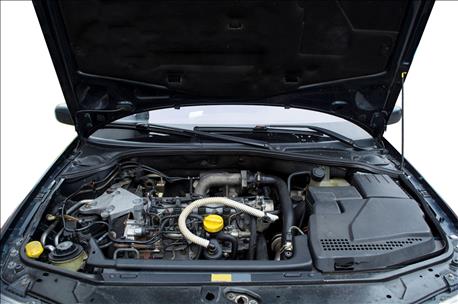
My daughter's coolant light came on when she was home from Georgia over the holidays. She drives a 2013 Ford Escape.
"Dad, should I take it to the repair place you go to?" she asked.
"Heck no," I said. "I can handle that. It just needs some anti-freeze in it. No problem."
Here are the top six reasons why I should have said "yes." Take it to the garage!

A lesson learned: Unless you're an engineer, take your car to a repair shop! (Thinkstock/ MarioGuti)
6. I thought I had anti-freeze on hand, but naturally I didn't. So I went into a convenience store to buy some. I grabbed a jug and went to pay. The clerk spoke something besides English, but I finally figured out he wanted me to go get another jug instead. Turns out I wanted the pre-mixed coolant, not pure anti-freeze. I don't buy it often enough to know.
5. A trained monkey should be able to open the anti-freeze jug. But a trained monkey might look at the directions before taking a screwdriver to the tab at the bottom of the cap. I wrongly assumed it tore off. Instead, you were supposed to push down at a spot on the tab. After 10 minutes and nearly jabbing myself with the screwdriver I had it open.
4. It shouldn't even take a trained monkey to open the hood. I found the lever inside the front passenger side, and pulled on it. Then I wedged my hands underneath the hood to move the latch. Hoods hardly ever pop up by themselves, at least not for me. I found the center post by feeling, but it seemed solid, there was no latch. I couldn't get the hood open
3. Instruction manuals aren't written by someone actually doing the job. My daughter finally convinced me to get the manual out. She found that believe it or not, this car has a hood latch at the front left side of the grill. Trick is finding it. The manual only says there is one, not where it's at. We finally found it, tripped it, and the hood opened. The part I was trying to move earlier in the center of the hood were steel rods firmly attached to the frame of the car.
2. Where the heck is the radiator cap? Nowhere – there isn't one – at least not that I found. The only cap is on the plastic coolant overflow located up near the car end of the hood. There was the cap. There was just one problem. Once I screwed it off and started to put my plastic funnel in, I realized the cap was recessed at least four inches under the hood! There was no way I was going to get anti-freeze into the radiator reservoir with that rigid funnel.
1. The car was obviously designed by someone who drives cars but never works on them! Heck, he or she probably couldn't get the hood up either. But I was determined. I grabbed an old oil spout once used to stick into the top of oil cans, when quarts of oil came in cans, circa 1950 technology, and carefully poured anti-freeze onto the lip of the spout. The spout extended just far enough to get the anti-freeze into the opening. Finally! The five-minute job that took 45 minutes was done!
When your daughter, or son, says, "Dad, my coolant light is on – should I go to the garage to get it fixed?' and it's a vehicle more than five years old, throw them your credit card, say "yes, go," and smile!
About the Author(s)
You May Also Like




